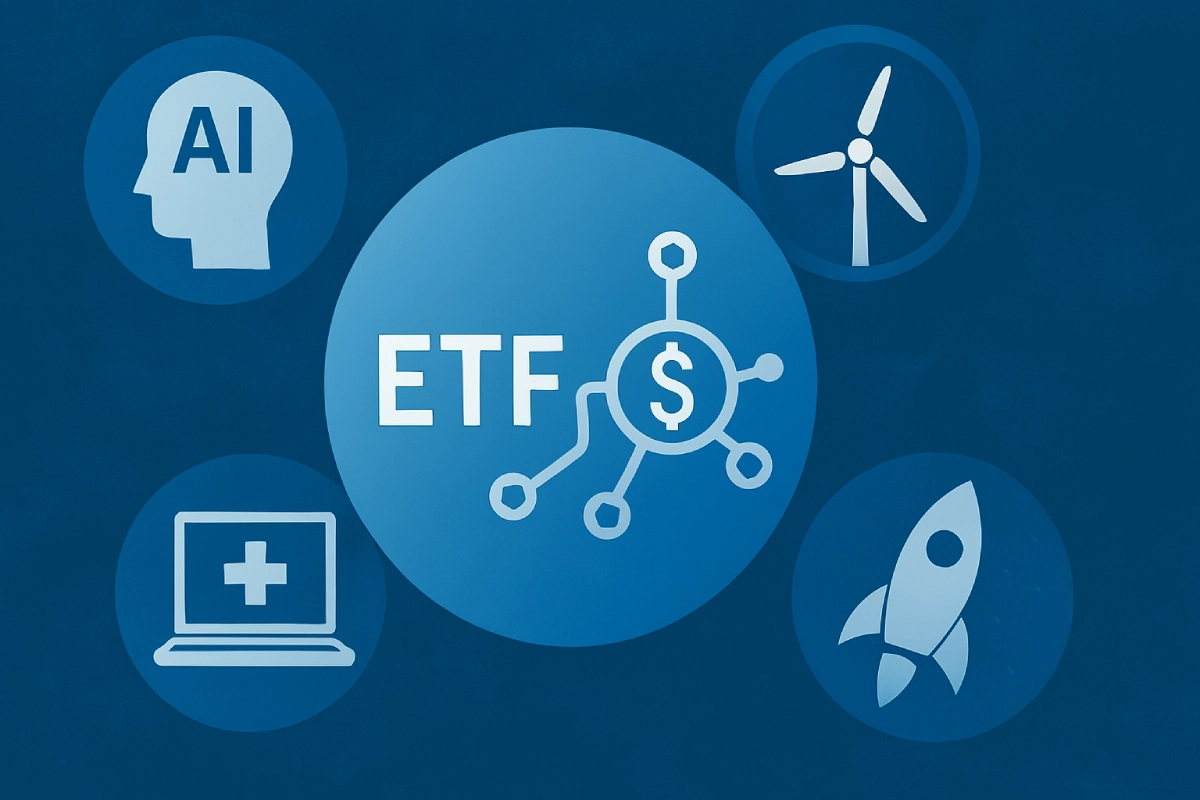In an investment landscape shaped by rapid technological change and evolving consumer behavior, many investors are seeking to position their portfolios to benefit from the trends shaping the future.
Enter thematic ETFs—a fast-growing corner of the exchange-traded-fund world that offers exposure to sectors and the powerful narratives and megatrends driving economic and societal transformation.
What Are Thematic ETFs?
Unlike traditional ETFs focusing on broad sectors (like technology or healthcare) or specific industries (such as semiconductors or pharmaceuticals), thematic ETFs are built around a unifying idea or trend. These themes could span across multiple sectors and geographies, making them uniquely positioned to capture the momentum of transformative changes.
Active vs. Passive: Two Paths to Thematic Exposure
Thematic ETFs come in both actively managed and passively managed flavors:
- Actively managed ETFs allow fund managers to make tactical decisions based on real-time market developments. This can be especially valuable in rapidly evolving areas like clean energy or AI.
- Passively managed ETFs track a specific index aligned with a theme, offering a rules-based approach to capturing the growth of that trend.
Why Investors Are Embracing Thematic ETFs
The popularity of thematic ETFs is surging—and for good reason.
1. Targeted Exposure to Big Ideas
Thematic ETFs allow investors to easily access themes like artificial intelligence, clean energy, digital healthcare, and space exploration—without needing to pick individual winners.
2. Potential for Long-Term Growth
Themes often align with emerging or disruptive trends. For example, the rise of AI has pushed certain chipmakers to the forefront of innovation—and into the portfolios of many thematic ETFs.
3. Diversification with a Twist
While thematic ETFs may be more concentrated than broad-market ETFs, they still offer exposure to multiple companies and sometimes across various sectors. This can provide a unique type of diversification, especially for investors who want to go beyond traditional asset classes.
4. Responsiveness to Change
Active thematic ETFs, in particular, can quickly adapt to new developments—pivoting away from underperforming areas and capitalizing on fresh opportunities.
Risks to Keep in Mind
Despite their appeal, thematic ETFs come with their own set of challenges:
- Volatility: Many themes are still in the early stages of development. This can lead to short-term price swings and heightened risk.
- Higher Fees: Actively managed or specialized thematic ETFs often carry higher expense ratios than broad market ETFs.
- Narrow Focus: Some themes might be too niche for investors who prefer broader market exposure. While the laser focus can lead to outsized gains, it also means more risk if the theme loses momentum.
- Long-Term Horizon Needed: These are often “story-driven” investments. To truly benefit, investors need patience—and belief in the long-term viability of the trend.
- Due Diligence Required: Not all ETFs are created equal. Two funds tracking the same theme may hold vastly different companies. Understanding the underlying holdings is key.
Thematic Investing in 2025: Where Are We Headed?
Recent developments underscore the growing relevance of thematic investing. The explosion of generative AI tools has renewed investor enthusiasm for AI-themed funds. Moreover, the SEC’s approval of spot Bitcoin ETFs earlier this year has opened the floodgates for digital asset-related thematic products. In the months ahead, we’ll likely see more innovation in thematic ETFs around blockchain, fintech, and next-gen internet applications in the months ahead.
Final Thoughts
Thematic ETFs are more than just trendy investment vehicles—they’re a window into the future. For investors seeking to align their portfolios with long-term economic and technological shifts, thematic ETFs can be a compelling tool.
Success in thematic investing comes down to timing, conviction, and careful research. These ETFs can be powerful additions to a portfolio—but only when they reflect a clear understanding of the theme and a willingness to stay the course through inevitable market fluctuations. As with all investments, diversification and discipline remain key. However, thematic ETFs may offer a front-row seat to the next wave of innovation.
Important Information Related to this Article
This material is for informational purposes only and contains the opinions of the author, which are subject to change, and should not be considered or interpreted as a recommendation to participate in any particular trading strategy or deemed to be an offer or sale of any investment product, and it should not be relied on as such. This material is not intended to provide investment recommendations. This material represents an assessment of the environment discussed at a specific time and is not intended to be a forecast of future events or a guarantee of future results. Readers of this information should consult their own financial advisor, lawyer, accountant, or other advisor before making any financial decision. Past performance is not indicative of future results. You cannot invest in an index.

